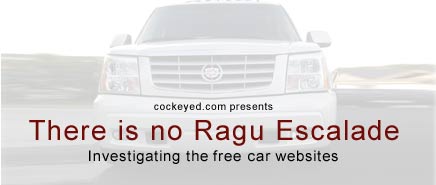 |
 |
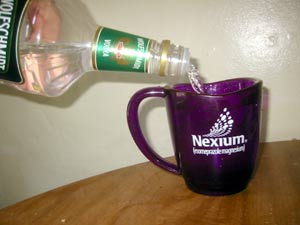 Advertising is a social science.
Advertising is a social science.Every company needs to get people to consider their product or services. They use television, radio, newspapers, magazines, websites, indoor billboards, outdoor billboards, fliers, and promotional items.

One relatively new form of outdoor advertising is car-wrapping. Instead of paint, a thin, flexible printed film is applied to every side of the car, including a perforated film over the rear windows. The result is an eye-catching three-dimensional rolling advertisement.
This form of advertising falls somewhere between billboards and painted delivery trucks.
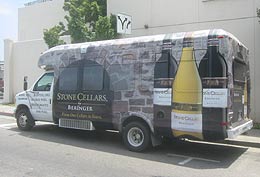
The van to the right is part of the buspool organization that arranges vanpools around San Francisco.
It has been wrapped in Stone Cellars by Beringer advertising, and I have to admit, it makes a big impression. When the van isn't on its long commute, it enjoys a prime parking spot throughout the working day, where thirsty tourists are exposed to the Beringer name.
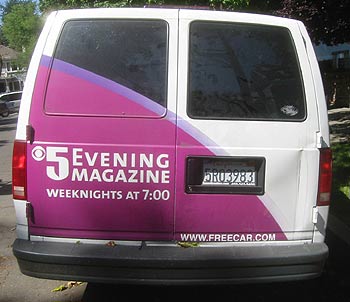
In 1998, when Davina gave me the tour of Yahoo headquarters, she pointed out a wrapped Yahoo car in the parking lot. She told me that the driver received a $200 monthly check to drive his wrapped car. She let me know that there was a waiting list for the next wrap job. She didn't have a car, but it was obvious that any employee would drive the Yahoo car without much encouragement. $200 was just icing on the cake.
In 1999, at the height of the internet gold rush, advertising prices in California quickly rose.
A clever group of advertising gurus realized that when the price of traditional billboard advertising rose, other outdoor advertising might become cost effective, in particular, car-wrapping. They announced that they were willing to lend ad-wrapped cars to highly-active drivers. They launched freecar.com.
Word spread quickly.
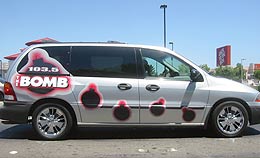
Soon, every single car in America was driving around with an ad on it.
Just kidding.
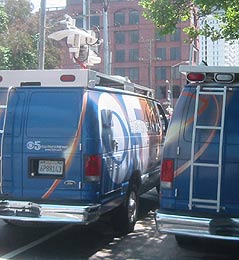
I don't actually know what happened to freecar.com. I assume that when times got hard in the tech sector, advertising rates plummeted and the wrapped car phenomenon became less attractive to potential advertisers.
Their site is gone now: www.freecar.com, and the Wayback Machine doesn't explain how they disappeared.
Of course, cars still get wrapped. I've seen an e-trade car, a Ferrari Color van, a Jelly Belly car, and several wrapped vans representing local radio stations.
People don't talk much about the free cars anymore.

At the end of April, 2003, Mark Willett from Boston wrote and asked if I had any information on the "free car" websites. I didn't realize they were even around still, but he motivated me to do some poking around.
Immediately I checked google, and sure enough, in their adwords section on the side of the screen, there were eight ads for websites offering free cars.
The free car sites want to sell you the easy road to free car
ownership. They tell the story of companies anxious to pay you $500-$3,200 a month to wrap your car in advertising, or offering a free
car to good drivers.
These sites sell a directory of companies who give away new vehicles and/or pay you to drive yours. They sell the directory for $19 to
$29:
www.free-car.com
www.thefreecar.com
www.findafreecar.com
www.totallyfreecars.com
www.dollars4-driving.com
www.freecarsource.com
www.instantfreecars.com
www.forfreecars.com
www.driving4dollars.com
www.freecardirectory.com
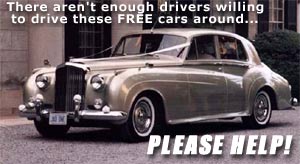
A free car. With advertising. I don't think so.
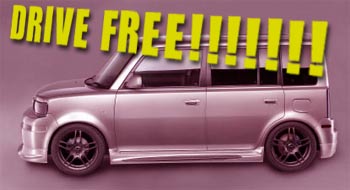
It struck me as a scam, but without paying the fee, I couldn't figure out exactly how it worked. There didn't seem to be any information revealing the "free car" secrets. I figured that there would be some unanticipated surprise, like you have to drive one of their salesmen around wherever you go or you have to wear a chicken outfit or something.
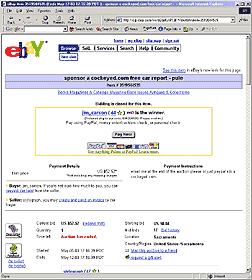
I decided the best way to figure out and expose the scam was to pay the
fee. I posted an auction, asking for financial help from the cockeyed.com readers.
The auction was a success, raising more than enough money to fund the project. The winner was Jim Carson from Seattle, Washington. Without his
contribution, this story would not have been written.
He paid immediately, and I got to work.
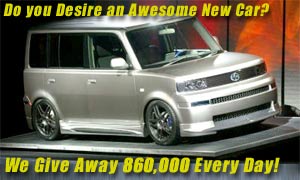
It was very strange to contribute to a scam.
In my investigation of the herbalife company, I had been able to find all kinds of information without spending a dime by simply using google, ebay, and phone calls. But in the case of the free cars, I was actually giving money to the organization I was fighting against.
Each free-car site uses Paypal or Clickbank for payment. Only two had business addresses listed (post office boxes), and none had a phone number.
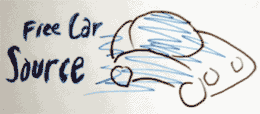 I
chose the free car site with strong promises: FreeCarSource.com.
I
chose the free car site with strong promises: FreeCarSource.com.
They have step-by-step instructions:
- Sign Up Now!
- Apply Online Instantly!
- Drive A Free Car!
I paid my $25 and was directed to a new page that tempered my non-existent expectations. It warned "Getting a company to sponsor you isn't easy" and "If you are going to park the car in your garage most of the time then don't even bother applying".
The next page was a list of companies that needed drivers, but to a list of 22 websites for car-wrapping companies.
Here they are! Act excited, because this exact same list cost me 25 bucks:
- drivers.freecarmedia.com
- www.autowraps.com
- www.idriveads.com
- www.ad-wraps.com
- www.autowrapped.com
- www.advercarzing.com
- www.adsmartoutdoor.com
- www.wrapyourauto.com
- www.vehiclead.com
- www.talkingwheels.com
- www.autocarwraps.com
- www.getpaidtodrive.com
- www.vistamotion.com
- www.carwraps.ca
- www.adstogo.ca
- www.ads2go.net
- www.automurals.com
- www.drivingpromotions.com
- www.onthemovemedia.com
- www.driveacar4free.com
- www.adcars-europe.co.uk
- www.carlogo.com
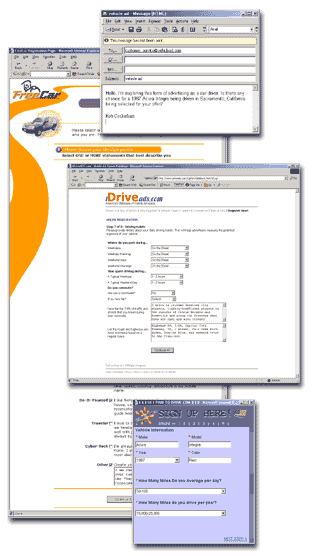 Each
site has forms where you can register as someone who was ready to drive
a wrapped car.
Each
site has forms where you can register as someone who was ready to drive
a wrapped car.
I chose seven sites that seemed the most legitimate and completed the forms honestly.
Each site had a 2-6 page application process with up to 50 questions. I gave my personal details such as address, hobbies, how far I drive each day, where I park my car, what freeways I use and whether I would be willing to attend special events. They didn't ask about my driving record.
The whole experience had a feeling of absurd futility to it. It was like filling out an application to be a movie star.
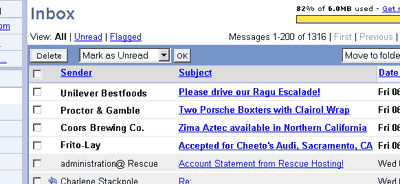
Later that day I was deluged with emails! Offers from Corporate America came rolling in! They had been searching for someone with my driver-profile for months!
I had my choice of the Ragu Escalade, the Clairol Porsche, the Zima Aztek and the Cheetos Audi TT.
Just kidding.
No one ever called or wrote.
This might be because I didn't fit their profile of a dedicated superdriver, or it might be because they don't actually ever give out free cars.
Or it could be because of my negative attitude.
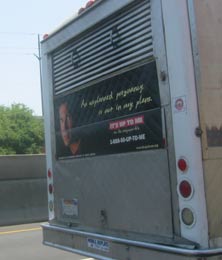
From an advertiser's point of view, a wrapped car driving around the busy city streets is not an unreasonable advertising option.
The art, production and installation of a car wrap costs about US$4,000.
Regular outdoor advertising, like billboards, were difficult to get prices for, but the Ballymore Outdoor website in Auckland shows some information, including a billboard trailer that they will park or hire a driver for. They sell a small, well placed billboard for $2,200 a month (New Zealand Dollars are worth about 60¢ US).
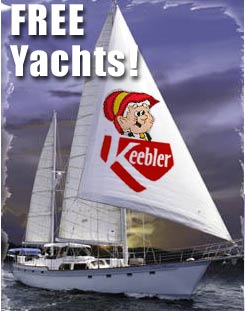
Advertising on the side of a car will only be as successful as the number of people that see it, so if a company was interested in rolling ads, they would probably choose vehicles that spend the most time in the most traffic.
Busses, taxis and airport shuttles are a good fit. Actually, maybe not taxis, because they are selling something else.
Most companies would give or lease the wrapped car to one of their salesmen, retailers or to sponsor a contest with the wrapped car as the prize. Beyond that, I suspect that they could partner with Hertz rent-a-car or offer the car to local celebrities instead. The advertiser would probably have his pick of drivers just by getting word out.
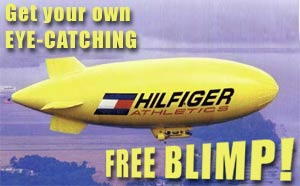
I didn't get a free car, and although I am very, very skeptical, I haven't proven that it is impossible to get a free car.
With that in mind, I invite anyone who reads this article to apply for a free car at one of the 22 sites listed above. If you get a free car, I'll post details of the whole affair. Please don't bother paying any of the sites that charge money.
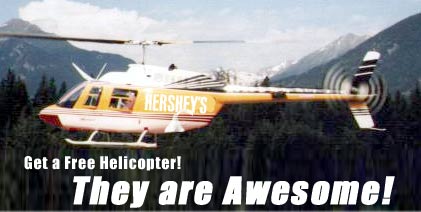
Until then, I'm going to promote my new Free Helicopter, Blimp and Yacht business! You just have to pay $39 for the membership kit, and you'll be on your way to owning your own magnificent vessel!
